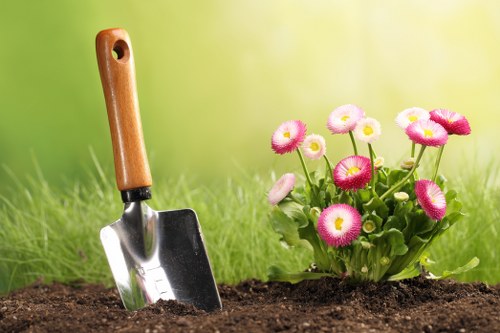Mastering Hedge Trimming in Greenwich: Achieve a Pristine Garden
Why Hedge Trimming is Essential

Maintaining healthy and aesthetically pleasing hedges is a cornerstone of a beautiful garden. Hedge trimming in Greenwich not only enhances the visual appeal of your outdoor space but also promotes the health and longevity of your plants.
Regular trimming helps in shaping the hedges, preventing them from becoming overgrown and unruly. It removes dead or diseased branches, allowing more light and air to penetrate the foliage, which is crucial for healthy growth.
Moreover, well-maintained hedges can serve as effective privacy screens, noise barriers, and windbreaks, adding both functionality and charm to your property.
Understanding the Benefits of Professional Hedge Trimming

While DIY hedge trimming might seem cost-effective, hiring professionals ensures that the job is done correctly and efficiently. Professional hedge trimmers in Greenwich bring expertise and experience, handling various hedge types with precision.
Experts can identify and address specific issues such as pest infestations, diseases, or structural weaknesses in your hedges. They use the right tools and techniques, minimizing the risk of damage to your plants.
Additionally, professional services save you time and effort, allowing you to focus on other aspects of garden maintenance or simply enjoy your outdoor space.
Choosing the Right Tools for Hedge Trimming

Having the appropriate tools is vital for effective hedge trimming. Essential tools include:
- Pruning Shears: Ideal for small, precise cuts.
- Hedge Trimmers: Suitable for shaping and maintaining larger hedges.
- Loppers: Perfect for cutting thicker branches that pruners can't handle.
- Protective Gear: Gloves, goggles, and appropriate clothing to ensure safety.
Investing in high-quality tools not only makes the trimming process easier but also ensures clean cuts that promote healthy regrowth.
Regular maintenance and proper care of your tools extend their lifespan and maintain their effectiveness.
Step-by-Step Hedge Trimming Techniques

1. Assessing the Hedge
Before you begin, evaluate the overall health and shape of your hedge. Identify any dead or diseased branches that need removal.
2. Planning the Shape
Decide on the desired shape and size. Common shapes include formal geometric forms or natural, flowing lines.
3. Trimming the Sides
Start by trimming the sides, working from the bottom upwards to ensure an even cut and prevent taller sections.
4. Shaping the Top
When shaping the top, maintain a consistent angle to allow sunlight to reach all parts of the hedge.
5. Cleaning Up
After trimming, remove all clippings and debris to keep the area tidy and prevent potential pest issues.
Seasonal Considerations for Hedge Trimming

Spring
Early spring is ideal for initial trimming to encourage new growth after winter.
Summer
Light maintenance during summer helps keep the hedge in shape and manage any rapid growth.
Autumn
Trimming in autumn prepares hedges for the dormant winter months, promoting resilience.
Winter
Avoid heavy trimming during winter to protect plants from cold damage.
Common Mistakes to Avoid in Hedge Trimming
Over-Trimming
Removing too much foliage can stress the plants, making them susceptible to diseases and pests.
Using the Wrong Tools
Incorrect tools can cause ragged cuts, harming the hedge and hindering healthy growth.
Ignoring Hedge Health
Failing to address underlying health issues can lead to irreversible damage.
Maintaining Healthy Hedges Post-Trimming
Regular Inspection
Frequently check your hedges for signs of pests, diseases, or other issues.
Proper Watering
Ensure consistent watering, especially during dry spells, to support recovery and growth.
Fertilization
Apply appropriate fertilizers to provide essential nutrients for robust health.
Mulching
Mulch around the base to retain moisture and suppress weeds.
Eco-Friendly Hedge Trimming Practices
Using Sustainable Tools
Opt for manual or electric trimmers to reduce carbon footprint compared to gas-powered alternatives.
Recycling Clippings
Compost trimmed branches and foliage to create nutrient-rich soil amendments.
Promoting Biodiversity
Maintain natural shapes and leave some foliage to support local wildlife habitats.
Water Conservation
Implement efficient watering systems to minimize water waste during the trimming process.
Benefits of Regular Hedge Trimming
- Enhanced Curb Appeal: Neatly trimmed hedges improve the overall look of your property.
- Healthier Plants: Removing dead or diseased branches promotes vigorous growth.
- Increased Privacy: Well-maintained hedges provide better screening from neighbors and passersby.
- Safety: Prevent overgrown hedges from interfering with walkways, driveways, and structures.
- Environmental Benefits: Healthy hedges support local ecosystems and wildlife.
Consistent trimming ensures that hedges remain a valuable and attractive aspect of your garden for years to come.
Hiring the Best Hedge Trimming Services in Greenwich
Experience and Expertise
Ensure the service provider has a proven track record and expertise in handling various hedge types.
Customer Reviews
Check reviews and testimonials to gauge the quality and reliability of the service.
Pricing and Packages
Compare pricing structures and service packages to find a solution that fits your budget and needs.
Insurance and Certifications
Verify that the company is insured and holds necessary certifications for safe and professional work.
Scheduling and Availability
Choose a service that offers flexible scheduling to accommodate your preferred timing.
DIY vs. Professional Hedge Trimming: Making the Right Choice
Deciding between DIY and professional hedge trimming depends on several factors:
- Time Commitment: DIY requires significant time and effort.
- Skill Level: Professionals ensure precise and clean cuts.
- Tool Availability: Professionals have access to specialized equipment.
- Cost: DIY may seem cheaper initially but can lead to higher costs if mistakes are made.
- Frequency: Regular trimming may benefit from professional schedules.
Evaluate your resources and priorities to make an informed decision that best suits your garden's needs.
Preparing Your Garden for Hedge Trimming
Clear the Area
Remove any obstacles or debris around the hedge to ensure easy access and prevent accidents.
Inspect the Hedges
Look for signs of disease, pests, or damage that need to be addressed during trimming.
Gather Necessary Tools
Ensure all your tools are clean, sharp, and in good working condition before starting.
Plan Your Trimming Schedule
Determine the best time of day and year for trimming to optimize plant health and growth.
Safety First
Wear appropriate protective gear to safeguard against potential injuries during the trimming process.
Innovative Techniques in Modern Hedge Trimming
Electric Hedge Trimmers
Electric trimmers offer precision and ease of use, making them ideal for detailed shaping.
Battery-Powered Tools
Battery-operated equipment provides mobility without the hassle of cords, enhancing efficiency.
Automated Trimming Systems
Advanced systems can automate the trimming process, saving time and ensuring consistent results.
Eco-Friendly Practices
Incorporating sustainable techniques reduces environmental impact while maintaining hedge health.
Integrated Garden Management
Combining hedge trimming with other garden maintenance tasks creates a harmonious and well-kept outdoor space.
Enhancing Curb Appeal with Perfectly Trimmed Hedges
Well-trimmed hedges significantly boost the curb appeal of your home, making it more inviting and visually appealing.
Strategically placed and shaped hedges can highlight architectural features, create focal points, and add depth to your landscape design.
Consistent maintenance ensures that your hedges remain a standout feature, reflecting your attention to detail and commitment to a beautiful garden.
Common Hedge Types and Specific Trimming Needs
Buxus (Boxwood)
Boxwoods are popular for their dense, evergreen foliage. They require precise trimming to maintain their shape.
Privet
Privet hedges are fast-growing and can be easily shaped. Regular trimming prevents them from becoming too large.
Yew
Yews are versatile and can be shaped into various forms. They respond well to both pruning and trimming.
Laurel
Laurels are robust and can tolerate heavy trimming, making them ideal for privacy screens.
Holly
Holly hedges need careful trimming to preserve their spiky leaves and bright berries, adding seasonal interest.
Final Thoughts on Hedge Trimming in Greenwich
Effective hedge trimming is a blend of art and science, requiring the right tools, techniques, and timing. Whether you choose to undertake the task yourself or hire professionals, the key is consistency and care.
By maintaining your hedges, you not only enhance the beauty of your garden but also contribute to a healthier and more sustainable outdoor environment.
Contact us today to book your hedge trimming service in Greenwich and transform your garden into a stunning oasis.

